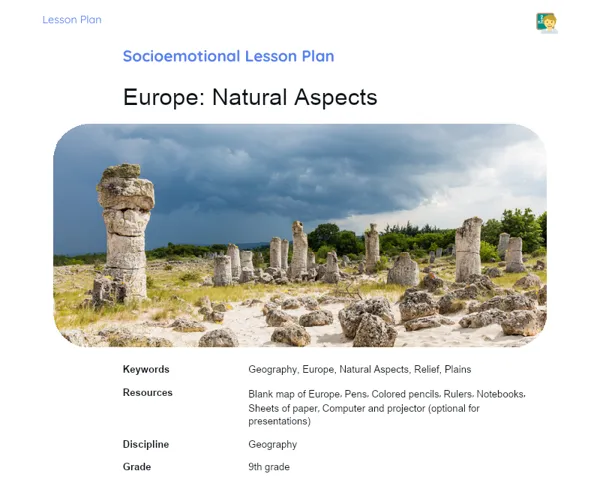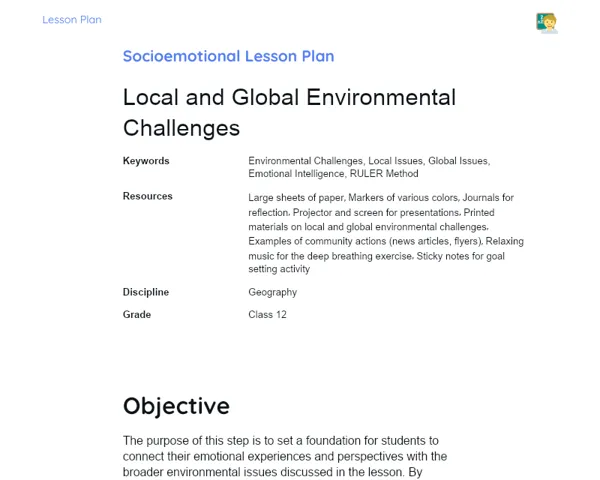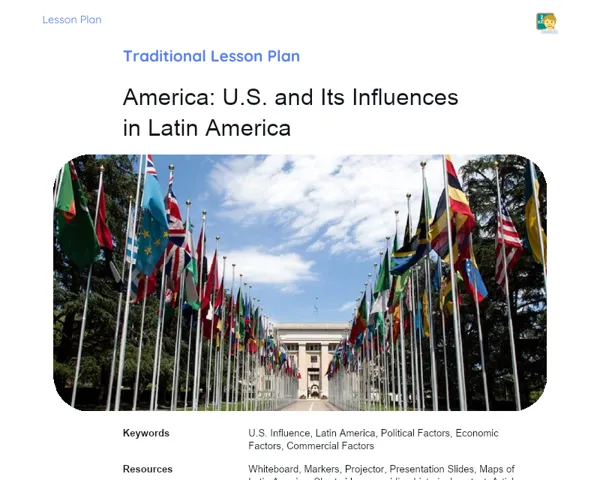Lesson Plan | Active Methodology | Drawings and Mind Maps
| Keywords | Drawings, Mind Maps, Geographical Representation, Map Interpretation, Practical Activities, Teamwork, Critical Thinking, Creativity, Application of Knowledge, Communication and Planning |
| Necessary Materials | Partially completed mind maps, Large paper, Colored markers, Blank sheets, Prize for the winning group |
Premises: This Active Lesson Plan assumes: a 100-minute class duration, prior student study both with the Book and the beginning of Project development, and that only one activity (among the three suggested) will be chosen to be carried out during the class, as each activity is designed to take up a large part of the available time.
Objective
Duration: (5 - 10 minutes)
This stage is crucial for setting a strong foundation for what students are expected to accomplish during the lesson. It helps focus both students and teachers on the established learning objectives, ensuring clarity for everyone involved. This initial understanding eases the way into practical activities, allowing students to effectively apply their prior knowledge.
Objective Utama:
1. Enable students to identify and distinguish between drawings, mind maps, and models as effective ways to illustrate their surroundings.
2. Enhance practical skills so students can create simple drawings and mind maps using knowledge they've gathered at home.
Objective Tambahan:
- Encourage students' creativity and imagination in depicting geographical aspects.
Introduction
Duration: (15 - 20 minutes)
The introduction aims to engage students by connecting the concepts they studied at home with hands-on application in class. The problem scenarios stimulate critical thinking on how to apply acquired knowledge in real or hypothetical situations, setting the stage for practical activity. The contextualization offers meaning behind what they're learning, illustrating its relevance in daily life and history, which in turn boosts students' interest and enthusiasm.
Problem-Based Situation
1. Imagine you're drawing a map of the route you take every day from home to school. What important details would you include so that someone unfamiliar with this path can easily follow it?
2. You've been asked to help organise a surprise birthday party for a friend who's new to the city. How can you use a mind map to organise various planning steps, like choosing a venue, making a guest list, and deciding on activities?
Contextualization
Mind maps and drawings are powerful tools not only in the classroom but also in our day-to-day life. For instance, creating a mind map helps in organising ideas before writing an essay or planning an event. Drawings, apart from being a form of art, are vital for representing and understanding geographical spaces. Historically, great explorers documented their discoveries with drawings and maps, producing valuable insights for future journeys. These skills can and should be nurtured from an early age in enjoyable and educational ways.
Development
Duration: (70 - 75 minutes)
The development stage is geared towards enabling students to collaboratively and practically apply the concepts related to drawings and mind maps that they learned at home. These activities allow students to creatively explore geographical spaces, enhancing their reading and interpretation skills alongside fostering teamwork and critical thinking. It’s essential to solidify learning and ensure students not only comprehend but also effectively and meaningfully utilise tools for geographical representation.
Activity Suggestions
It is recommended that only one of the suggested activities be carried out
Activity 1 - The Hidden Treasure on the Map
> Duration: (60 - 70 minutes)
- Objective: To develop skills in reading and interpreting mind maps while fostering teamwork and critical thinking.
- Description: In this fun-filled activity, students will form groups of up to five and receive a partially completed mind map depicting a park. Their task is to help a fictional character uncover a treasure by following clues laid out on the mind map. The clues will involve elements from the park, like trees, lakes, and even tiny drawings representing landmarks.
- Instructions:
-
Organise students into groups of no more than five.
-
Provide each group with a partially completed mind map.
-
Explain that the map illustrates a park containing clues to find hidden treasure.
-
Ask students to examine the map and discuss possible routes and locations indicated by the clues.
-
Every correct clue leads to another part of the park until the treasure is finally found.
-
The first group to locate the treasure by correctly following the clues wins a small prize.
Activity 2 - Building the City of Dreams
> Duration: (60 - 70 minutes)
- Objective: To nurture creativity and spatial awareness while encouraging argumentative and justification skills.
- Description: In groups, students will create both a mind map and a drawing of their dream city. They should incorporate residential areas, commercial zones, parks, transport hubs, and cultural attractions. Later on, they will justify their selections for each part of the city.
- Instructions:
-
Organise students into groups of up to five members.
-
Provide each group with large sheets of paper and coloured markers.
-
Guide groups in sketching out their ideal city, including features like homes, shops, parks, and public transport facilities.
-
Instruct them to craft a mind map that explains the rationale behind each element they've drawn.
-
At the end, allow each group to present their city to the class, articulating their choices.
-
Encourage a discussion regarding the diverse ideas and solutions each group offers.
Activity 3 - Adventure on the Knowledge Map
> Duration: (60 - 70 minutes)
- Objective: To develop the ability to synthesise and organise information while improving communication and collaboration among students.
- Description: This activity is a 'treasure hunt' within the students’ own knowledge. Each group will receive a blank sheet representing an empty mind map. They need to fill this map with ideas and concepts related to a given geography topic, using colours and drawings to connect and organise the information.
- Instructions:
-
Divide the class into groups of five.
-
Distribute a blank sheet as the base for each group's mind map.
-
Announce the specific geography theme to be explored.
-
Allow groups to discuss what they know about the topic, filling in the map with relevant information, drawings, and colours.
-
In the end, each group will present their mind map to the class, explaining how they organised the information and the significance of each part.
-
Conduct a collective review to reinforce learning.
Feedback
Duration: (10 - 15 minutes)
The aim of this stage is to solidify learning, allowing students to articulate the knowledge they've gained and share their experiences. Group discussions encourage reflection on their learning journeys and help students appreciate the diverse approaches and solutions presented by their peers. Furthermore, these discussions can identify any knowledge gaps, providing an opportunity for the teacher to clarify doubts or reinforce key concepts.
Group Discussion
At the end of the activities, gather all students for a group discussion. Start off by briefly explaining the importance of sharing experiences and learnings. Request each group to present what they created in summary, highlighting key points of the mind map or drawing and how they addressed the challenges posed during the activities. Encourage students to elucidate their choices and actively listen to their peers.
Key Questions
1. What were the biggest challenges faced while creating the mind map or drawing? How did you manage to overcome them?
2. How was the information arranged in the mind map, and how did that aid in understanding the content?
3. In what ways can you see today's activity being implemented in real-life scenarios or in other subjects?
Conclusion
Duration: (5 - 10 minutes)
This stage’s purpose is to ensure that students have a solid and clear understanding of the material covered during the lesson, directly relating it to the practical activities undertaken. Additionally, it strives to underscore the relevance of the topic in students' daily lives, encouraging the application of their learning in real scenarios and other subjects. This final reflection aids in reinforcing knowledge and underscores the significance of the skills developed, readying students to apply them in various contexts.
Summary
In this concluding section, the teacher should recap the main aspects discussed throughout the lesson, revisiting the various types of geographical representations explored, such as drawings, mind maps, and models. It’s also important to spotlight the practical activities completed, emphasising the learning outcomes related to the interpretation and creation of these representations.
Theory Connection
Today's lesson connected theory with practice seamlessly. Students had the opportunity to apply the theoretical understanding acquired at home through engaging activities like the mind map treasure hunt and designing an ideal city. These exercises not only reinforced theoretical concepts but also allowed creative exploration while developing essential skills in geographical representation and interpretation.
Closing
It's vital for students to recognise the significance and practical application of geographical representations in their everyday lives, not merely as academic tools but also as means of communication and planning in varied real-world situations. Using mind maps and drawings can greatly ease the organisation of ideas, problem-solving, and planning, marking them as invaluable skills across multiple contexts.



